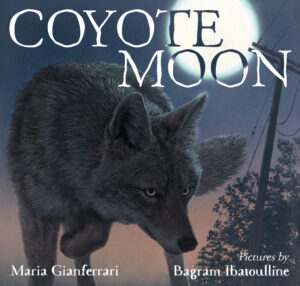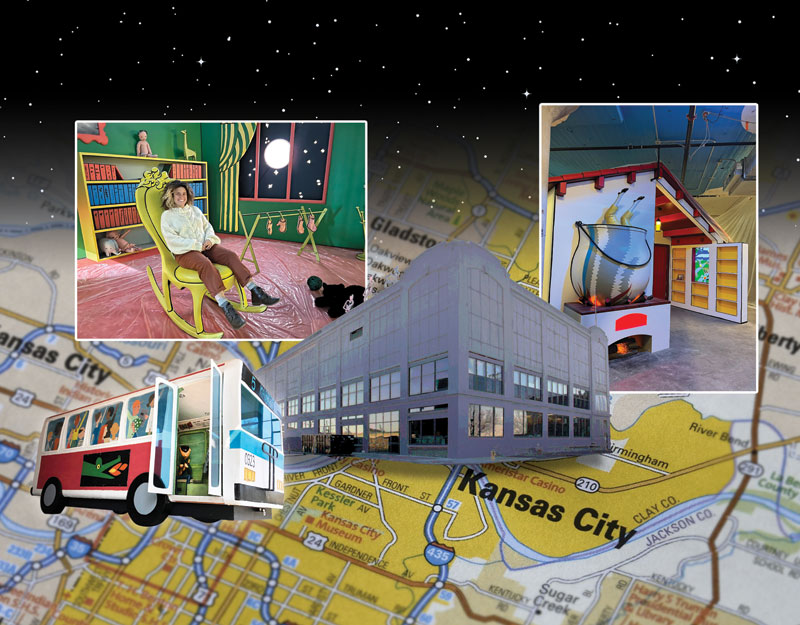Review of the Day: Coyote Moon by Maria Gianferrari
 Coyote Moon
Coyote Moon
By Maria Gianferrari
Illustrated by Bagram Ibatoulline
Roaring Brook Press (an imprint of Macmillan)
$17.99
ISBN: 978-1-62672-041-1
Ages 4-7
On shelves July 19th
I feel as if there was less nature out there when I was a kid. Crazy, right? But seriously, as I grew to be an adult I was appalled at the discovery that other people in the United States had to deal with stuff like ticks and chiggers and painful jellyfish and worse. Me? The worst encounter I ever had with something stinging or biting were a couple of sweat bees on my knuckles. But the critter that seemed the most impossible in terms of everyday encounters has been, and continues to be to this day (until the moment we come face-to-face) the coyote. Coyotes were always the heroes of Wild West tales of Native American folklore. They didn’t just wander into your Michigan backyard or anything . . . did they? Now, thanks to books like the beautiful Coyote Moon I learn that coyotes live in every American state except Hawaii. Best that I get as much information as possible about them then. Thankfully, I’ve lots of help. Maria Gianferrari and Bagram Ibatoulline ratchet up the realism to eleven, making it hard to walk away from this book without considering the modern coyote’s plight.
The sun has set and the moon is on the rise. What better time for a coyote momma to leave her den and search for tasty morsels for her kin? Slipping in and out of the shadows of a suburban neighborhood, the coyote attempts to secure a mouse, a rabbit, and even the eggs of Canadian geese, all to no avail. As the sun begins to rise in the east, however, the coyote smells, seas, and hears a flock of turkeys. There is no hemming or hawing now. Without another thought she secures a big one for her family. Of course, before she returns home, she howls. A potentially dangerous act to perform so close to humans, but fortunately the one person who hears her is the one person who understands why she would howl in the first place. Backmatter consists of Coyote Facts, Further Reading, and Websites.
ADVERTISEMENT
ADVERTISEMENT
 The book is not written in verse or rhyme, but there’s something inherently rhythmic to Ms. Gianferrari’s text. Listen to how she begins the book: “Moon rises, as Coyote wakes in her den, a hollow-out pine in a cemetery. Coyote crawls between roots. She sniffs the air, arches her back, shakes her fur.” That’s beautiful, that is. Gianferrari’s text is like that from start to finish and it all gets particularly interesting near the end. What an interesting choice it was to switch into the second person near the story’s end. “You open your window… You watch as Coyote slips under the fence painted pink by the sun.” Interesting too that the coyote gets her name capitalized throughout the story. She’s the heroine, no bones about it, and refusing to give her a name keeps her appropriately wild. Capitalizing the word “coyote”, however, gives just the slightest personal bent to an otherwise impersonal descriptive name.
The book is not written in verse or rhyme, but there’s something inherently rhythmic to Ms. Gianferrari’s text. Listen to how she begins the book: “Moon rises, as Coyote wakes in her den, a hollow-out pine in a cemetery. Coyote crawls between roots. She sniffs the air, arches her back, shakes her fur.” That’s beautiful, that is. Gianferrari’s text is like that from start to finish and it all gets particularly interesting near the end. What an interesting choice it was to switch into the second person near the story’s end. “You open your window… You watch as Coyote slips under the fence painted pink by the sun.” Interesting too that the coyote gets her name capitalized throughout the story. She’s the heroine, no bones about it, and refusing to give her a name keeps her appropriately wild. Capitalizing the word “coyote”, however, gives just the slightest personal bent to an otherwise impersonal descriptive name.
Which brings us to the art. I’ve been a big time fan of artist Bagram Ibatoulline for years. He’s one of those artists that are so good he’ll never ever win any American illustration awards. Such people exist all the time and this is particularly true of artists who truck with realism. Ibatoulline’s challenge here is twofold. On the one hand, he has to render the coyote and her environment in a nighttime setting without sacrificing detail. On the other hand, without giving his character any anthropomorphized tendencies, he also needs to make her sympathetic in her quest to provide food for her babies. The end result is fascinating to watch. With the aid of a full moon, Ibatoulline believably provides just enough light to justify seeing every single solitary hair on the coyote mama’s pelt. Often her eyes are the most colorful things on the page, aided in part by the streetlights as well. He even manages to give the sky that odd pink/grey color it sometimes takes on thanks to light pollution. I don’t know that I’ve ever seen it so perfectly rendered in a picture book before. Then there’s his ability to accurately render the light of an early dawn. We see the light striking the trees, the day beginning on the houses, and silhouetted against the lake the mama coyote. And even then, every single hair on her head is present and accounted for. How does he do that?
 I read almost every picture book I review to my kids at some point or another, and I’m glad that I do. Even after all these years, they have the ability to surprise me. For example, if you’d asked me if this were a tense or scary book in any way I’d have initially said no. Yet clearly the book is capable of touching a nerve. My staid stoic five-year-old daughter, who recently informed me that The Walking Dead couldn’t possibly be all that scary a show, was positively petrified by the image of the coyote making her first pounce. No wolf attacking Little Red Riding Hood has ever made such an impression on her as that shot. Fortunately, it’s almost as if Mr. Ibatoulline and Ms. Gianferrari anticipated this. As a parent I was able to smoothly flip back three pages and show the baby coyote cubs near the den and explain that this was their mama. The explanation went a far ways towards alleviating her anxiety. Later, when the coyote gets a big mouth of turkey, Ibatoulline frames the shot in such a way as to display minimal carnage. All you get is, on one page coyote’s face ending just under her nose and on the other the tail, drifting feathers indicating the turkey’s dire fate.
I read almost every picture book I review to my kids at some point or another, and I’m glad that I do. Even after all these years, they have the ability to surprise me. For example, if you’d asked me if this were a tense or scary book in any way I’d have initially said no. Yet clearly the book is capable of touching a nerve. My staid stoic five-year-old daughter, who recently informed me that The Walking Dead couldn’t possibly be all that scary a show, was positively petrified by the image of the coyote making her first pounce. No wolf attacking Little Red Riding Hood has ever made such an impression on her as that shot. Fortunately, it’s almost as if Mr. Ibatoulline and Ms. Gianferrari anticipated this. As a parent I was able to smoothly flip back three pages and show the baby coyote cubs near the den and explain that this was their mama. The explanation went a far ways towards alleviating her anxiety. Later, when the coyote gets a big mouth of turkey, Ibatoulline frames the shot in such a way as to display minimal carnage. All you get is, on one page coyote’s face ending just under her nose and on the other the tail, drifting feathers indicating the turkey’s dire fate.
Some folks might make the argument that this book is clearly nonfiction, and you could see their point. If we take the heroine of this story to be an average coyote and not a single one, thereby making this an average situation and not a specific one, then combined with the backmatter (the copious “Coyote Facts” as well as the bibliography for both further reading and websites) you almost find yourself in nonfiction territory. So out of curiosity I decided to see how my library’s distributor, Baker & Taylor, characterized the book. Lo and behold, they call it straight up nonfiction, no bones about it. Personally, I don’t agree. For whatever reason, for all that the book is informative and interesting, I still found the storyline just a tad too fictionalized to count as a purely informational text. Why is this? Compare the book to Hungry Coyote by Cheryl Blackford, a book that Baker & Taylor classifies as fictional. In both cases you have average coyote storylines, and both very realistic indeed. Gianferrari has the leg up in this case since her book has nonfiction backmatter, but in both cases I felt like I was hearing a story more than I was learning factual information. Certainly authors can do both, but at the end of the day it’s the librarians who’ll decide where to shelve the puppy. And to my mind, any picture book collection should be honored to receive this book.
After finishing Coyote Moon I truly believe I have a better sense of coyotes now, and not a moment too soon. Just the other day I was told that the house I’m currently renting is on a little street, dubbed by the neighbors “Coyote Way”. I was told not to be surprised if I see those cheerful souls walking down the road to their destination. And while I have no desire to get up close and personal with the clan, it would be cool to watch from my windows. So thank you, Ms. Gianferrari and Mr. Ibatoulline for giving me the confidence, courage, and curiosity to see this through. I have little doubt that those qualities, to a certain extent the very benchmarks of childhood itself, will resonate with curious young readers everywhere. Lots of younger kids love wolves. These coyotes are about to give those wolves a real run for their money. Beautiful work. Beautiful stuff.
On shelves July 19th.
Source: Galley sent from publisher for review.
Like This? Then Try:
- Hungry Coyote by Cheryl Blackford
- Wild Animal Neighbors by Ann Downer
- Faraway Fox by Jolene Thompson
Filed under: Best Books, Best Books of 2016, Reviews, Reviews 2016
About Betsy Bird
Betsy Bird is currently the Collection Development Manager of the Evanston Public Library system and a former Materials Specialist for New York Public Library. She has served on Newbery, written for Horn Book, and has done other lovely little things that she'd love to tell you about but that she's sure you'd find more interesting to hear of in person. Her opinions are her own and do not reflect those of EPL, SLJ, or any of the other acronyms you might be able to name. Follow her on Twitter: @fuseeight.
ADVERTISEMENT
ADVERTISEMENT
SLJ Blog Network
The Moral Dilemma of THE MONSTER AT THE END OF THIS BOOK
Winnie-The-Pooh | Review
Parsing Religion in Public Schools
ADVERTISEMENT








At a time when the kidlit community is scrutinizing invented dialog, imagined scenes, and fictional POV characters in life stories of people, I think it makes sense to closely examine animal life stories as well.
I love Coyote Moon because the rich language (The sensory details are to die for.) is a joy to read and the compelling storyline offers us a window into the life and survival needs and natural instincts of an animal that many people consider a nuisance or worse. In that way, it reminds me of Mosquito Bite by Alexandra Siy.
The book is perfect for use in teaching both ELA and science lessons. But is it nonfiction? Did someone record all the activities of a specific mother coyote over a period of time and is the text completely true to those records? Based on the back matter, that doesn’t seem to be true.
Instead, the activities are a composite based on typical behaviors of many coyotes that have been monitored by scientists. Everything in the book is accurate and could be true for a specific individual coyote, but is that enough to make it nonfiction?
Sandra Markle has created a half dozen books with illustrator Alan Marks that are similar to Coyote Moon. Titles include Little Lost Bat, A Mother’s Journey (about a penguin), Hip-pocket Papa (about a frog), Waiting for Ice (about polar bears), and Family Pack (about wolves). While the Library of Congress classifies these as nonfiction, Sandra considers them fiction.
I am becoming increasingly fond of the term “informational fiction” to describe life stories, historical books, and science-themed books that are largely true and accurate but not completely supported by documented research. In some cases, taking creative liberties with true, documentable facts may be an effective way to share ideas and information with young readers, but we need to be upfront with children. It’s important to let them know what’s real and what’s not.